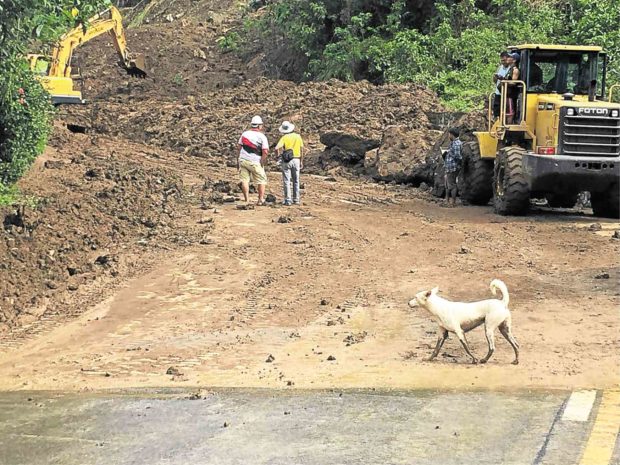Women matter in CamSur town’s disaster response plan

PET CONCERN In this photo taken in January, a dog lingers in a landslide-hit area in Sagñay, Camarines Sur, as rescuers clear mud and rocks that buried houses in Barangay Patitinan. STEPHANIE FLORIDA
SAGÑAY, Camarines Sur, Philippines — Gender will be considered in the disaster risk reduction and management (DRRM) plan of this town as officials reflect on the lessons learned when a weak storm killed 36 people in December last year.
Donato Panoy, Sagñay DRRM officer, said they could have saved more residents if only women had a voice in deciding whether or not a household should be evacuated in anticipation of weather disturbances.
“On the gender issue that the men decide for the household, the women do not have a voice. So even the children perished. If only the women are empowered to decide without the permission of their husbands, they would have survived,” Panoy told the Inquirer.
An example was the Erno family who lost 10 of its members from landslides triggered by rains from Tropical Depression “Usman.”
Panoy said the wife was waiting for the husband, who was trapped in Tiwi town, Albay province, when the rains started. “The wife said she would wait for the husband because he might get angry if they left without him,” he said.
Article continues after this advertisementBeyond rescue, evacuation
Article continues after this advertisement“We always think that disaster management is all about rescue or evacuation. But behind that, there is an issue that we need to talk about,” Panoy said.
Of the 36 dead and 10 missing residents in Sagñay, 26 were female, including the youngest victim who was only three months old. All victims were from Barangay Patitinan.
Panoy said the town did not have an evacuation center that may house residents from Barangay Sibaguan, Patitinan and Bongalon, which are all facing the Pacific Ocean. These villages are being considered to be declared as “no build” zones.
Forty-eight landslides were recorded in the areas during the onslaught of Usman.
Sagñay has three distinct geographical areas — coastal, mountainous and urbanized — but the three villages and Barangay Turague are always at risk when typhoons hit.
“We are not only counting the number of families to relocate, but we are looking at a number of communities,” Panoy said, adding that at least 1,700 households would be affected.
IP communities
In Sagñay, 13 indigenous peoples (IP) communities, some of them found in the three villages, have to be evacuated, he said.
While none of the casualties in Sagñay was an IP member, Panoy said they had consulted the National Commission on Indigenous Peoples for the transfer of these communities.
“Because the reason for the possible evacuation is to save lives, they may be allowed to leave their homes although in terms of livelihood, they can be allowed to till their lands there,” he said.
Marites Brizuela, chair of Barangay Sibaguan, said that despite having an evacuation place in their village, she was still worried about the safety of her village mates.
“If the mountain erodes because of the lack of trees that can hold the soil together and prevent flooding, the village hall and the high school will be hit by the landslide,” she told the Inquirer.
“The geohazard assessment showed that there is no safe area here anymore,” she said.